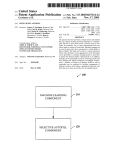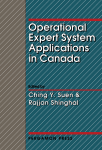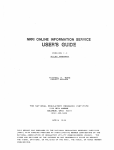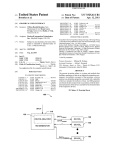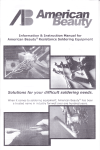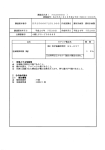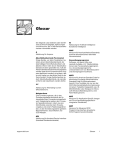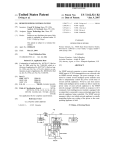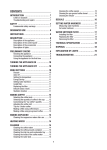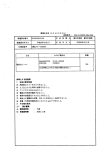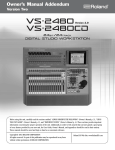Download Simulation of a PCI device`s memory
Transcript
US007155379B2
(12)
(54)
(75)
United States Patent
(10) Patent N0.:
Oshins et a].
(45) Date of Patent:
US 7,155,379 B2
Dec. 26, 2006
SIMULATION OFA PCI DEVICE’S
6,748,461 B1*
6/2004 Oshins et a1. ................ .. 710/8
MEMORY-MAPPED I/O REGISTERS
6,810,442 B1 *
10/2004 Lin et al. .................... .. 710/22
I
t
nven ors:
J
b 0 h_
S
n1
WA (Us)
6,820,219 B1* 11/2004 Huang et al. ............... .. 714/25
aco
s lIlS, ea e,
;
Brandon Allsops Monroe’ WA (Us)
*
6,980,944 B1
2003/0149962 A1*
12/2005
8/2003
.
Oshins et al. . . . . .
. . . .. 703/17
Wlllls et al. .............. .. 717/135
(73) Assignee: Microsoft Corporation, Redmond, WA
(Us)
(*)
Notice:
Subject to any disclaimer, the term of this
patent is extended or adjusted under 35
U'SC' 154(1)) by 670 days‘
OTHER PUBLICATIONS
“
_
_
”
PCISIMASlmulatlon Tool for PCI Bus Based Systems ,R. Sharp,
User’s Manual, Dec. 1999*
(21) Appl. No.: 10/374,439
(22) Filed:
(Continued)
Feb‘ 25’ 2003
(65)
Primary ExamineriFred Ferris
74Azzomey’ A gen 2’ 0r F'Wm iAm'In’ Turocy’ &Cl'
£LI),
a Vm’
Prior Publication Data
US 2004/0236564 A1
Nov. 25, 2004
(57)
(51)
Int. Cl.
G06F 13/10
ABSTRACT
(2006.01)
(52)
G06F 9/44
(2006-01)
US. Cl. .......................... .. 703/21; 703/13; 703/14;
703/17; 703/20; 703/23; 703/24; 710/8; 710/22
PCI simulation component has an initialization component,
(58)
Field of Classi?cation Search ................ .. 703/13,
a Con?guration space simulator and a memory-mapped I/O
'
(56)
A component, system and method for simulation of a PCI
deviee’s memory-mapped I/O register(s) are provided, The
703/14, 20, 21, 23, 24, 17; 714/25, 733;
space simulator. The initialization component can claim an
' 710/22, 8
amount of memory by modifying the amount of memory
~
See aPPhCaUOn ?le for Complete Search hlstoryReferences Cited
that an operating system has available to it. The initialization
component further identi?es to the operating system that at
least some of the claimed memory resides on a PCI bus. The
US. PATENT DOCUMENTS
6,026,230 A *
6,182,242
6,279,122
6,324,609
6,336,152
6,374,340
6,418,485
B1
B1
B1
B1
B1
B1
6,442,514 B1*
2/2000
1/2001
8/2001
11/2001
1/2002
4/2002
7/2002
8/2002
Lin et a1. .................... .. 703/13
Brogan et al.
Hitchcock et al.
Davis et a1.
Richman et a1.
Lanus et a1.
Cooper et al.
and can comprise can comprise a thread that monitors the
simulated memory-mapped l/O registers for a change in
order to simulate behavior of the simulated PCI device.
Additionally and/or alternatively, the memory-mapped l/O
Le ............................ .. 703/21
6,484,227 B1
11/2002 Mergard et a1.
6,484,281 B1*
11/2002 Wang et a1. .............. .. 714/733
6,499,074 B1
12/2002 Mehta et a1.
6,629,157 B1*
9/2003
Falardeau et a1.
con?guration space simulator causes the operating system to
accept that the simulated PCI device is present in the system.
The memory-mapped l/O space simulator simulates device
space simulator can comprise a thread that changes at least
one of the simulated memory mapped l/O registers in order
to simulate behavior of the simulated PCI device.
19 Claims, 7 Drawing Sheets
.......... .. 710/10
f 400
PCI SlMULATlON
1°“ —\ COMPONENT
420
l'NlTIALIZATION
’
CoMPowEm
DEVICE DRIVER
ASSOCIATED WITH
CONFIGURATION
SIMU'I ATED Pci
EvlcE
T
SPACE
SIMULATOR
MEMORY-MAPPED
/
‘
l/OSPACE
SIMULATOR
P01 DRIVER
4 440
10/
PLUG AND
PLAY
MANAGER
OPERATING
SYSTEM
200
US 7,155,379 B2
Page 2
OTHER PUBLICATIONS
PCI-SIG, PCI Local Bus Speci?cation Revision 3.0, Aug. 12, 2002,
1-344, PCI-SIG, Portland, OR.
“An Integrated Approach to PCI Subsystem Veri?cation in SOC’s”,
D. Duxstad, EETimes, 2000*
“PCI Device Compliance Testing Using a Mixed C-Verilog Envi
Yan Shoumeng, et al.; “A Simulation Framework for Device Driver
ronment”, D. Duxstad et al.*
4 Pages.
“A Design Modleing and Simulation Methodology for PCI-X
Subsystems”, M. Cases et al, IEEE 0-7803-6450-3/00, 2000 IEEE.*
* cited by examiner
Development”; Northwestern Polytechnical University; Dec. 2002;
U.S. Patent
110 JR
Dec. 26, 2006
Sheet 1 0f 7
US 7,155,379 B2
INITIALIZATION
COMPONENT
120 ‘\
CONFIGURATION SPACE
'
SIMULATOR
130 1_\ MEMORY-OMAPPED I/O SPACE
SIMULATOR
PCI SIMULATION COMPONENT
100
FIG. 1
U.S. Patent
Dec. 26, 2006
Sheet 2 0f 7
US 7,155,379 B2
r 200
MEMORY
FOR PCI
SIMULATION
COMPONENT
USE
MAXMEM
MEMORY
FOR
OPERATING
SYSTEM USE
FIG. 2
U.S. Patent
Dec. 26, 2006
Sheet 3 0f 7
US 7,155,379 B2
300
PCI Header
f
DeviceID
VendorlD
Status
Command
Base
class
‘
BIST
8 ub -c 1 ass
P rog1F
R ev ID
Header
Latency
Cache
Type
Timer
Line Size
Base Address Register 0
V
/—'3 1 00
- /— 3101
Base Address Register 1
/— 3102
Base Address Register 2
3103
Base Address Register 3
3104
Base Address Register 4
/—
Base Address Register 5
/_
3 1O 5
Subsystem Vendor/Device 1])
ROM Base Address Register
Reserved
Max
Latency
.
Mm Grant
Cap Ptr
Interrupt
Interrupt
Pin
Line
FIG. 3
U.S. Patent
Dec. 26, 2006
Sheet 4 0f 7
US 7,155,379 B2
400
[
PCI SIMULATION
100 \ COMPONENT
420
DEVICE DRIVER
INITIALIZATION /— 110
/ COMPONENT
ASSOCIATED WITH
SIMULATED PCI
DEVICE
A
/_ 120
CONFIGURATION
SPACE
SIMULATOR
MEMORY-MAPPED
/4
T 130
I/O SPACE
SIMULATOR
4
/— 430
PCI DRIVER
,— 440
PLUG AND
/
PLAY
MANAGER
OPERATING
SYSTEM
410/
200 —/
FIG. 4
U.S. Patent
Dec. 26, 2006
(
START
Sheet 5 0f 7
US 7,155,379 B2
>
f 500
V
CLAIM AN AMOUNT OF MEMORY
’
510
I
IDENTIFY AT LEAST SOME OF THE CLAIMED
MEMORY AS RESIDING ON A PCI BUS
/— 520
i
IDENTIFY A SIMULATED PCI DEVICE TO AN
/— 530
OPERATING SYSTEM
EMPLOY AT LEAST SOME OF THE CLAIMED
540
MEMORY AS SIMULATED MEMORY-MAPPED I/O ’
REGISTERS OF THE SIMULATED PCI DEVICE
I
LOAD A DEVICE DRIVER ASSOCIATED WITH THE V— 550
SIIVIULATED PCI DEVICE
l
_ INSTANTIATE A THREAD THAT MONITORS THE
SIMULATED MEMORY-MAPPED 1/0 REGISTERS /_ 560
FOR A CHANGE IN ORDER TO SIMULATE
BEHAVIOR OF THE SIMULATED PCI DEVICE
I
INSTANTIATE A THREAD THAT CHANGES AT
LEAST ONE OF THE SIMULATED MEMORY
/~ 570
MAPPED I./O REGISTERS IN ORDER TO SIMULATE
BEHAVIOR OF THE SIMULATED PCI DEVICE
FIG. 5
U.S. Patent
Dec. 26, 2006
Sheet 6 6f 7
@
US 7,155,379 B2
66""
I
LOAD A DEVICE DRIVER ASSOCIATED WITH THE /'— 610
SIMULATED PCI DEVICE
i
INSTANTIATE A THREAD THAT MONITORS THE
SIMULATED MEMORY-MAPPED I/O REGISTERS /_ 620
FOR A CHANGE IN ORDER TO SIMULATE
BEHAVIOR OF THE SIMULATED PCI DEVICE
I
INSTANTIATE A THREAD THAT CHANGES AT
LEAST ONE OF THE SIMULATED MEMORY
/" 630
MAPPED I./O REGISTERS IN ORDER TO SIMULATE
BEHAVIOR OF THE SIMULATED PCI DEVICE
FIG. 6
U.S. Patent
Dec. 26, 2006
Sheet 7 0f 7
US 7,155,379 B2
/— 728
l
i """"""" ". """""""""""""" "l
|
5 Operating System 5
|
________________ __
I
------------------------------------ --
710
f
730
i i_.‘.’tPP_1.i_‘?3t_i2P§-§
r 732
-------------- —-{
|l
Modules
I
_______ "("
|
2
.
£22122...
/ 712
K
I‘ ‘'1
¢‘:‘:‘: ‘Edgy 714
Processing E
742
Unit
K
...... u 2
Output
: "v,v'v.no".gog‘o‘tao‘o‘o‘og’g
716
/
System
"14
OuFPu'F
A d ap
D
\
k
738
1 Memory
740
K
Interface 1:
Volatile
720
>
Poms)
Input
Device(s)
Non Volatile
K
\
736
/ 722 K 718
(I)
______ 5
Interface
m
\ 726
750
K
.
Network
Communication
Interface
Connection(s)
A
K 748
—->
v
Remote
C0mputer(s)
-
724
744 J W
746 /
FIG. 7
US 7,155,379 B2
1
2
SIMULATION OF A PCI DEVICE’S
MEMORY-MAPPED I/O REGISTERS
device. The present invention can thus signi?cantly reduce
the amount of time during Which a PCI device is available
TECHNICAL FIELD
Without softWare support (e.g., device driver(s) associated
With the PCI device).
In accordance With an aspect of the present invention, the
The present invention relates generally to PCI device(s),
PCI simulation component simulates aspect(s) of a simu
lated PCI device, for example, those Which are visible to
softWare in the memory-mapped I/O space. The PCI simu
and, more particular to simulation of a PCI device’s
memory-mapped I/O register(s).
lation component further simulates the con?guration space
BACKGROUND OF THE INVENTION
for the simulated PCI device.
The Peripheral Component Interface (PCI) bus is a high
The initialization component performs initialization for
the PCI simulation component. The initialization component
performance 32-bit or 64-bit bus With multiplexed address
claims an amount of memory from a computer system. The
and data lines. The bus is intended for use as an interconnect
initialization component can accomplish this by modifying
mechanism betWeen highly integrated peripheral controller
components, peripheral add-in cards, and processor/memory
the amount of memory that the operating system has avail
able to it. By claiming some of the memory for itself, the
systems. PCI is a Widely accepted and implemented expan
initialization component can then operate on that memory
sion standard.
HardWare vendors of PCI device(s) have pressure from
the computer marketplace to have software in place as PCI
Without colliding With the operating system. This can be
necessary, for example, since the operating system generally
20
device(s) become available. This has traditionally lead to
limited time and/or ability to debug softWare for the PCI
device(s). Additional problem(s) can occur When the PCI
device(s) require infrastructure from operating system(s).
The introduction of Personal Computer Memory Card Inter
national Association (PCMCIA) standard for cards inserted
into the side of laptop computers, Universal Serial Bus
(USB) standard, and Bluetooth standard for Wireless com
munication are examples of situations in Which hardWare
device(s) Were introduced With little or no operating system
25
30
infrastructure facilitating interconnection.
The folloWing presents a simpli?ed summary of the
35
Description Table (“DSDT”) in order to represent at least
40
based, at least in part, upon a ?lter driver that modi?es a
resource requirement reported by a root PCI bus hierarchy to
include at least some of the claimed memory. In yet a third
45
example, this identi?cation can be based, at least in part,
upon modi?cation of a BIOS description of memory. In yet
a fourth example, this identi?cation can be based, at least in
part, upon modi?cation of the memory that the operating
system uses by passing arguments to a kernel of the oper
50
ating system.
55
Once the initialization component has taken control of at
least some of the claimed memory and caused the operating
system to accept that it resides on a PCI bus, the con?gu
ration space simulator then causes the operating system to
accept that the simulated PCI device is present in the system
(e.g., the con?guration space simulator identi?es the simu
lated PCI device to the operating system). Identi?cation of
signi?cantly reduce cost(s) associated With PCI device simu
60
some of the claimed memory as residing on a PCI bus.
lated PCI device, thus, permitting development and/or test
ing of a device driver associated With the simulated PCI
the simulated PCI device to the operating system can be
based, at least in part, upon simulation of contents of PCI
con?guration space associated With the simulated PCI
device.
The con?guration space simulator can hook functions in
the operating system that read and Write con?guration space.
Thereafter, the PCI simulation component identi?es the
simulated PCI device to the operating system. The PCI
simulation component further simulates behavior of a simu
some of the claimed memory as being part of a root of a PCI
bus hierarchy. In another example, this identi?cation can be
simulators can be prohibitive. The present invention can
lation.
The PCI simulation component claims an amount of
memory from a computer system. The PCI simulation
component then identi?es to an operating system at least
resides on a PCI bus. In one example, this identi?cation can
Con?guration and PoWer Interface speci?cation (“ACPI”)
Basic Input/Output System (“BIOS”) Differentiated System
the actual PCI device(s) Were available. This resulted in
signi?cant period(s) of time during Which hardWare Was
physically available but not available for use by computer
system(s). HardWare-level simulators for PCI device(s)
exist; hoWever, cost(s) associated With the hardWare-level
claimed memory is then utilized by the con?guration space
simulator and/or the memory-mapped I/O space simulator.
For example, the initialization component can provide infor
mation to the operating system’s boot ?le causing the
operating system kemel’s memory manager to stop using the
portion for use by the PCI simulation component (e.g.,
be based, at least in part, upon modi?cation of an Advance
lation of PCI device(s) (e.g., hardWare) thus reducing dif?
culties With traditional method(s) of developing softWare for
PCI device(s). Conventionally, it has been dif?cult to create
softWare (e.g., device driver(s)) for neW PCI device(s) until
memory.
In one example, the initialization component claims an
amount of memory by reducing an amount of memory
available to the operating system. At least some of the
add/MAXMEM as an argument in a boot.ini ?le.)
The initialization component further identi?es to the
operating system that at least some of the claimed memory
SUMMARY OF THE INVENTION
invention in order to provide a basic understanding of some
aspects of the invention. This summary is not an extensive
overvieW of the invention. It is not intended to identify
key/critical elements of the invention or to delineate the
scope of the invention. Its sole purpose is to present some
concepts of the invention in a simpli?ed form as a prelude
to the more detailed description that is presented later.
The present invention provides for a PCI simulation
component comprising an initialization component, a con
?guration space simulator and a memory-mapped I/O space
simulator. The PCI simulation component facilitates simu
attempts to enforce a separation betWeen address space used
by device(s) (e.g., PCI device(s)) and that used by main
Thus, When a PCI driver in the operating system scans the
65
PCI bus, the con?guration space simulator can provide data
that convinces the PCI driver that the simulated PCI device
is present in the system. Since the information stored in the
US 7,155,379 B2
4
3
con?guration space for the PCI device also contains regis
ters that control Which part of the memory-mapped I/O
FIG. 6 is a How chart of a method for a PCI device
simulation in accordance With an aspect of the present
invention.
FIG. 7 illustrates an example operating environment in
Which the present invention may function.
space the device uses, the con?guration space simulator can
pre-populate those (virtual) registers With the physical
address of the claimed memory of Which it has taken control.
Thus, simulation of contents of PCI con?guration space can
include populating at least one base register With an address
associated With the claimed memory (e. g., claimed memory
DETAILED DESCRIPTION OF THE
INVENTION
acting as simulated memory-mapped I/O register(s) of the
simulated PCI device).
The present invention is noW described With reference to
the draWings, Wherein like reference numerals are used to
Thereafter, the PCI driver can communicate to a Plug and
refer to like elements throughout. In the folloWing descrip
tion, for purposes of explanation, numerous speci?c details
Play manager that the simulated PCI device has been added
to the system. The PCI driver can also communicate to the
Plug and Play manager that the simulated PCI device is
are set forth in order to provide a thorough understanding of
using the address space that claimed memory. This causes
the Plug and Play manager to load a device driver associated
With the simulated PCI device. Thus, the PCI simulation
the present invention. It may be evident, hoWever, that the
present invention may be practiced Without these speci?c
details. In other instances, Well-knoWn structures and
component facilitates testing/development of the simulated
PCI device, for example, before the actual hardWare (PCI
device) is available.
The memory-mapped I/O space simulator simulates
devices are shoWn in block diagram form in order to
20
nent” is intended to refer to a computer-related entity, either
hardWare, a combination of hardWare and softWare, soft
behavior of a simulated PCI device. The memory-mapped
I/O space simulator can comprise a thread that monitors the
Ware, or softWare in execution. For example, a computer
component may be, but is not limited to being, a process
simulated memory-mapped I/O registers (e.g., in the
claimed memory) for a change in order to simulate behavior
of the simulated PCI device. Additionally and/or alterna
tively, the memory-mapped I/O simulator can comprise a
thread that changes at least one of the simulated memory
25
30
one computer and/or distributed betWeen tWo or more com
driver associated With the simulated PCI device makes to the
simulated memory-mapped registers (e.g., in the claimed
35
system registers and the virtual address belonging to the
context varies as it executes.
40
To the accomplishment of the foregoing and related ends,
certain illustrative aspects of the invention are described
herein in connection With the folloWing description and the
annexed draWings. These aspects are indicative, hoWever, of
45
With traditional method(s) of developing softWare for PCI
device(s). Conventionally, it has been di?icult to create
softWare (e.g., device driver(s)) for neW PCI device(s) until
50
system(s).
The PCI simulation component 100 claims an amount of
BRIEF DESCRIPTION OF THE DRAWINGS
55
memory from a computer system (not shoWn). The PCI
simulation component 100 then identi?es to an operating
system (not shoWn) at least some of the claimed memory as
residing on a PCI bus. Thereafter, the PCI simulation
component 100 identi?es the simulated PCI device to the
FIG. 1 is a block diagram of a PCI simulation component
in accordance With an aspect of the present invention.
FIG. 2 is a block diagram of an exemplary memory in
accordance With an aspect of the present invention.
FIG. 3 is a block diagram of an exemplary PCI header in
accordance With an aspect of the present invention.
FIG. 4 is a block diagram of a PCI simulation system in
accordance With an aspect of the present invention
60
FIG. 5 is a How chart of a method of simulation of a PCI
65
an aspect of the present invention.
the actual PCI device(s) Were available. This resulted in
signi?cant period(s) of time during Which hardWare Was
physically available but not available for use by computer
draWings.
device’s memory-mapped I/O registers in accordance With
Referring to FIG. 1, a PCI simulation component 100 in
accordance With an aspect of the present invention is illus
trated. The PCI simulation component 100 comprises an
initialization component 110, a con?guration space simula
tor 120 and a memory-mapped I/0 space simulator 130.
The PCI simulation component 100 facilitates simulation
of PCI device(s) (e.g., hardWare) thus reducing dif?culties
but a feW of the various Ways in Which the principles of the
invention may be employed and the present invention is
intended to include all such aspects and their equivalents.
Other advantages and novel features of the invention may
become apparent from the folloWing detailed description of
the invention When considered in conjunction With the
knoWn in the art, each thread has an associated “context”
Which is the volatile data associated With the execution of
the thread. A thread’s context includes the contents of
thread’s process. Thus, the actual data comprising a thread’s
Using these technique(s), the memory-mapped I/O space
simulator can virtually create some and/or substantially all
of the activity of an actual PCI device.
computer components may reside Within a process and/or
thread of execution and a component may be localiZed on
puters. A “thread” is the entity Within a process that the
operating system kernel schedules for execution. As is Well
tinually scan the memory looking for changes that the device
memory). The memory-mapped I/O space simulator can
also Write change(s) into the memory that Will be perceived
by the device driver of the simulated PCI device as
change(s) in the simulated PCI device’s hardWare state.
running on a processor, a processor, an object, an executable,
a thread of execution, a program, and/ or a computer. By Way
of illustration, both an application running on a server and
the server can be a computer component. One or more
mapped I/O registers (e.g., in the claimed memory) in order
to simulate behavior of the simulated PCI device.
Thus, the memory-mapped I/O space simulator can con
facilitate describing the present invention.
As used in this application, the term “computer compo
operating system. The PCI simulation component 100 fur
ther simulates behavior of a simulated PCI device, thus,
permitting development and/or testing of a device driver
(not shoWn) associated With the simulated PCI device (not
shoWn). The present invention can thus signi?cantly reduce
the amount of time during Which a PCI device is available
Without softWare support (e.g., device driver(s) associated
With the PCI device).
US 7,155,379 B2
5
6
PCI device(s) typically implement three address spaces:
I/O, memory-mapped I/ 0 and con?guration. “I/O space” can
correspond, for example, to an I/O space of an Intel-brand
?cation can be based, at least in part, upon modi?cation of
a BIOS description of memory. In yet a fourth example, this
identi?cation can be based, at least in part, upon modi?ca
processor. “Con?guration space” is used generally for set
ting up the PCI device.
tion of the memory that the operating system uses by passing
arguments to a kernel of the operating system.
“Memory-mapped I/O space” can involve a PCI device
Once the initialiZation component 110 has taken control
Which has control register(s) in address space traditionally
of at least some of the claimed memory and caused the
operating system to accept that it resides on a PCI bus, then
the con?guration space simulator 120 can cause the oper
addressed as memory. While the control register(s) are
addressed as “memory”, the value(s) Written and read from
a particular control register can be different, as distinguished
from memory (e.g., RAM) Which generally returns the same
value that Was last Written. For example, for a complicated
device such as a USB controller, the control register(s) don’t
just store previously Written valuesia bit can have meaning
(e.g., one bit can indicate that a USB port is active While
another bit can enable the port.).
In accordance With an aspect of the present invention, the
PCI simulation component 100 simulates aspect(s) of a
simulated PCI device, for example, those Which are visible
to softWare in the memory-mapped I/O space. The PCI
10
120 identi?es the simulated PCI device to the operating
system). Identi?cation of the simulated PCI device to the
operating system can be based, at least in part, upon simu
lation of contents of PCI con?guration space associated With
the simulated PCI device (e.g., by the con?guration space
simulator 130).
The con?guration space simulator 120 can hook functions
20
simulation component 100 further simulates the con?gura
tion space for the simulated PCI device. Thus, the PCI
simulation component 100 of the present invention can
employ memory and software to simulate the behavior of a
PCI device’s memory-mapped register(s).
25
The initialiZation component 110 performs initialiZation
for the PCI simulation component 100. The initialiZation
component 110 claims an amount of memory from a com
puter system (not shoWn). For example, the initialiZation
component 100 can accomplish this by modifying the
30
amount of memory that the operating system has available
to it. By claiming some of the memory for itself, the
in the operating system that read and Write con?guration
space. Thus, When a PCI driver (not shoWn) in the operating
system scans the PCI bus, the con?guration space simulator
120 can provide data that convinces the PCI driver that the
simulated PCI device is present in the system. Since the
information stored in the con?guration space for the PCI
device also contains registers that control Which part of the
memory-mapped I/O space the device uses, the con?gura
tion space simulator 120 can pre-populate those (virtual)
registers With the physical address of the claimed memory of
Which it has taken control. Thus, simulation of contents of
PCI con?guration space can include populating at least one
base register With an address associated With the claimed
memory (e.g., claimed memory acting as simulated
memory-mapped I/O register(s) of the simulated PCI
initialiZation component can then operate on that memory
Without colliding With the operating system. This can be
necessary, for example, since the operating system generally
ating system to accept that the simulated PCI device is
present in the system (e.g., the con?guration space simulator
device).
35
For example, referring brie?y to FIG. 3, an exemplary
by device(s) (e.g., PCI device(s)) and that used by main
PCI header 300 in accordance With an aspect of the present
invention is illustrated. The header 300 includes a plurality
memory.
In one example, the initialization component 110 claims
an amount of memory by reducing an amount of memory
available to the operating system. At least some of the
of ?elds including Base Address Register 0 3100, Base
Address Register 1 3101, Based Address Register 2 3102,
Base Address Register 3 3103, Base Address Register 4 3104
and Based Address Register 5 3105, collectively referred to
attempts to enforce a separation betWeen address space used
40
claimed memory is then utiliZed by the con?guration space
simulator 120 and/or the memory-mapped I/O space simu
lator 130. Referring brie?y to FIG. 2, an exemplary memory
200 in accordance With an aspect of the present invention is
illustrated. The memory 200 comprises a portion for use by
the operating system 210 and a portion for use by the PCI
simulation component 220 (e.g., PCI simulation component
100). For example, the initialiZation component 110 can
provide information to the operating system’s boot ?le
causing the operating system kemel’s memory manager to
stop using the portion for use by the PCI simulation com
as Base Address Registers 310. One or more of the Base
45
municate to a Plug and Play manager (not shoWn) that the
50
boot.ini ?le.)
55
of the claimed memory resides on a PCI bus. In one
example, this identi?cation can be based, at least in part,
upon modi?cation of an Advance Con?guration and PoWer
(“DSDT”) in order to represent at least some of the claimed
memory as being part of a root of a PCI bus hierarchy. In
another example, this identi?cation can be based, at least in
part, upon a ?lter driver that modi?es a resource requirement
reported by a root PCI bus hierarchy to include at least some
of the claimed memory. In yet a third example, this identi
(PCI device) is available.
The memory-mapped I/O space simulator 130 simulates
behavior of a simulated PCI device. The memory-mapped
I/ O space simulator 130 can comprise a thread that monitors
further identi?es to the operating system that at least some
Interface speci?cation (“ACPI”) Basic Input/Output System
(“BIOS”) Di?ferentiated System Description Table
simulated PCI device has been added to the system. The PCI
driver can also communicate to the Plug and Play manager
that the simulated PCI device is using the address space
backed by the claimed memory. This causes the Plug and
Play manager to load a device driver associated With the
simulated PCI device (not shoWn). Thus, the PCI simulation
component 100 facilitates testing/development of the simu
lated PCI device, for example, before the actual hardWare
ponent 220 (e.g., add/MAXMEM as an argument in a
Referring back to FIG. 1, the initialiZation component 110
Address Registers 310 can include a pointer to the claimed
memory.
Returning to FIG. 1, thereafter, the PCI driver can com
the simulated memory-mapped I/O registers (e.g., in the
60
claimed memory) for a change in order to simulate behavior
of the simulated PCI device. Additionally and/or altema
tively, the memory-mapped I/O space simulator 130 can
comprise a thread that changes at least one of the simulated
memory mapped I/O registers (e.g., in the claimed memory)
65
in order to simulate behavior of the simulated PCI device.
Thus, the memory-mapped I/O space simulator 130 can
continually scan the memory looking for changes that the
US 7,155,379 B2
7
8
device driver associated With the simulated PCI device
the operating system 410 to accept that the simulated PCI
device is present in the system (e.g., the PCI simulation
component 100 identi?es the simulated PCl device to the
makes to the simulated memory-mapped registers (e.g., in
the claimed memory). The memory-mapped l/O space simu
lator 130 can also Write change(s) into the memory that Will
operating system 410). Identi?cation of the simulated PCI
be perceived by the device driver of the simulated PCI
state. Using these technique(s), the memory-mapped l/O
device to the operating system can be based, at least in part,
upon simulation of contents of PCI con?guration space
associated With the simulated PCI device (e.g., by the
space simulator 130 can virtually create some and/or sub
con?guration space simulator 120). The con?guration space
device as change(s) in the simulated PCI device’s hardWare
stantially all of the activity of an actual PCI device.
For example, the process of directing a simulated PCI
device’s memory-mapped l/O ranges toWard system RAM
simulator 120 of the PCI simulation component 100 can
hook functions in the operating system 410 that read and
Write con?guration space. Thus, When a PCI driver 430 in
the operating system 410 scans the PCI bus, the con?gura
alloWs the device driver for the simulated device to access
that RAM as it Would real device register(s), since both the
tion space simulator 120 can provide data that convinces the
PCI driver 430 that the simulated PCl device is present in the
RAM and the actual device (Which doesn’t exist yet) exist in
Memory Address Space. The same operating system primi
tives for reading, Writing and/or mapping that memory Will
component 110, the con?guration space simulator 120 and/
system. Since the information stored in the con?guration
space for the device also contains the registers that control
Which part of the memory-mapped l/O space the device
uses, the con?guration space simulator 120 can pre-populate
those (virtual) registers With the physical address of the
memory of Which it has taken control. Thus, simulation of
contents of PCI con?guration space can include populating
or the memory-mapped l/O space simulator 130 can be
at least one base register With an address associated With the
Work.
While FIG. 1 is a block diagram illustrating components
for the PCI simulation component 100, it is to be appreciated
that the PCI simulation component 100, the initialiZation
20
implemented as one or more computer components, as that
claimed memory (e.g., claimed memory acting as simulated
term is de?ned herein. Thus, it is to be appreciated that
memory-mapped l/O register(s) of the simulated PCI
computer executable components operable to implement the
PCI simulation component 100, the initialiZation component
25
Thereafter, the PCI driver 430 can communicate to a Plug
and Play manager 440 that the simulated PCI device has
110 and/ or the memory-mapped l/O space simulator 130 can
be stored on computer readable media including, but not
limited to, an ASIC (application speci?c integrated circuit),
CD (compact disc), DVD (digital video disk), ROM (read
been added to the system. The PCl driver 430 can also
30
only memory), ?oppy disk, hard disk, EEPROM (electri
cally erasable programmable read only memory) and
memory stick in accordance With the present invention.
Turning to FIG. 4, a PCI simulation system 400 in
accordance With an aspect of the present invention is illus
trated. The system 400 includes a PCI simulation component
100, memory 200 and an operating system 410. Optionally,
35
The memory-mapped l/O space simulator 130 of the PCI
PCI device. The memory-mapped l/O space simulator 130
can comprise a thread that monitors the simulated memory
40
45
simulation component 100 then identi?es to the operating
50
operating system 410. The PCl simulation component 100
further simulates behavior of a simulated PCI device, thus,
permitting development and/or testing of the device driver
associated With the simulated PCI device 420. The present
invention can thus signi?cantly reduce the amount of time
during Which a PCI device is available Without software
support (e.g., device driver associated With the PCI device
55
420).
system 410, the device driver associated With a simulated
PCI device 420, the PCI driver 430 and/ or the Plug and Play
manager 440 can be computer components as that term is
de?ned herein.
memory-mapped register(s).
410 to accept that it resides on a PCI bus, then it must cause
changes that the device driver associated With the simulated
PCI device 420 makes to the simulated memory-mapped
registers in the claimed memory 220. The memory-mapped
l/O space simulator 130 can also Write change(s) into the
claimed memory 220 that Will be perceived by the device
driver of the simulated PCI device 420 as change(s) in the
simulated PCI device’s hardWare state. Using these tech
nique(s), the memory-mapped l/O space simulator 130 can
virtually create some and/or substantially all of the activity
It is to be appreciated that the system 400, the operating
60
simulated PCI device. Thus, the PCI simulation component
100 of the present invention can employ memory and
softWare to simulate the special behavior of a PCI device’s
Once the PCI simulation component 100 has taken control
of the claimed memory 220 and caused the operating system
mapped l/O space simulator 130 can comprise a thread that
changes at least one of the simulated memory mapped l/O
registers in the claimed memory 220 in order to simulate
behavior of the simulated PCI device.
Thus, the memory-mapped l/O space simulator 130 can
continually scan the claimed memory 220 looking for
of an actual PCI device.
The PCT simulation component 100 simulates aspect(s) of
a simulated PCI device and the con?guration space for the
mapped l/O registers in the claimed memory 220 for a
change in order to simulate behavior of the simulated PCI
device. Additionally and/or alternatively, the memory
As discussed supra, the PCI simulation component 100
comprises an initialiZation component 110, a con?guration
system 410 at least some of the claimed memory 220 as
residing on a PCI bus. Thereafter, the PCI simulation
component 100 identi?es the simulated PCI device to the
hardWare (PCl device) is available.
simulation component 100 simulates behavior of a simulated
prior to availability of the actual PCI device(s).
space simulator 120 and a memory-mapped l/O space simu
lator 130. The PCT simulation component 100 claims an
amount of memory 200ithe claimed memory 220. The PCT
communicate to the Plug and Play manager 440 that the
simulated PCI device is using the address space that claimed
memory. This causes the Plug and Play manager 440 to load
the device driver associated With the simulated PCl device
420. Thus, the system 400 facilitates testing/ development of
the simulated PCI device, for example, before the actual
the system 400 can include a device driver associated With
a simulated PCI device 420. The system 400 facilitates
simulation of PCI device(s) (e.g., hardWare), for example,
device).
Turning brie?y to FIGS. 5 and 6, methodologies that may
65
be implemented in accordance With the present invention are
illustrated. While, for purposes of simplicity of explanation,
the methodologies are shoWn and described as a series of
US 7,155,379 B2
10
the simulated memory mapped I/O registers in order to
simulate behavior of the simulated PCI device is instantiated
(e.g., a memory-mapped I/O space simulator 130).
In order to provide additional context for various aspects
of the present invention, FIG. 7 and the folloWing discussion
are intended to provide a brief, general description of a
suitable operating environment 710 in Which various aspects
of the present invention may be implemented. While the
invention is described in the general context of computer
executable instructions, such as program modules, executed
blocks, it is to be understood and appreciated that the present
invention is not limited by the order of the blocks, as some
blocks may, in accordance With the present invention, occur
in different orders and/or concurrently With other blocks
from that shoWn and described herein. Moreover, not all
illustrated blocks may be required to implement the meth
odologies in accordance With the present invention.
The invention may be described in the general context of
computer-executable instructions, such as program modules,
executed by one or more components. Generally, program
modules include routines, programs, objects, data structures,
etc. that perform particular tasks or implement particular
abstract data types. Typically the functionality of the pro
by one or more computers or other devices, those skilled in
the art Will recogniZe that the invention can also be imple
mented in combination With other program modules and/or
as a combination of hardWare and softWare. Generally,
gram modules may be combined or distributed as desired in
various embodiments.
Referring to FIG. 5, a method of simulation of a PCI
hoWever, program modules include routines, programs,
objects, components, data structures, etc. that perform par
ticular tasks or implement particular data types. The oper
ating environment 710 is only one example of a suitable
operating environment and is not intended to suggest any
device’s memory-mapped I/O registers 500 in accordance
With an aspect of the present invention is illustrated. At 510,
an amount of memory is claimed (e.g., by a PCI simulation
component 100). For example, claiming the amount of
20
able to the operating system.
At 520, at least some of the claimed memory is identi?ed
as residing on a PCI bus (e.g., by an initialiZation component
110). For example, identi?cation of at least some of the
25
claimed memory as residing on a PCI bus can be based, at
least in part, upon modi?cation of an ACPI BIOS Di?feren
tiated System Description Table in order to represent at least
30
for implementing various aspects of the invention includes
a computer 712. The computer 712 includes a processing
unit 714, a system memory 716, and a system bus 718. The
some of the claimed memory as residing on a PCI bus can
be based, at least in part, upon a ?lter driver that modi?es a
resource requirement reported by a root PCI bus hierarchy to
include at least some of the claimed memory. In yet another
example, identi?cation of at least some of the claimed
computers, hand-held or laptop devices, multiprocessor sys
tems, microprocessor-based systems, programmable con
sumer electronics, netWork PCs, minicomputers, mainframe
computers, distributed computing environments that include
the above systems or devices, and the like.
With reference to FIG. 7, an exemplary environment 710
some of the claimed memory as being part of a root of a PCI
bus hierarchy. In another example, identi?cation of at least
limitation as to the scope of use or functionality of the
invention. Other Well knoWn computer systems, environ
ments, and/or con?gurations that may be suitable for use
With the invention include but are not limited to, personal
memory can include reducing an amount of memory avail
system bus 718 couples system components including, but
35
not limited to, the system memory 716 to the processing unit
714. The processing unit 714 can be any ofvarious available
memory as resident on a PCI bus is based, at least in part,
processors. Dual microprocessors and other multiprocessor
upon modi?cation of a BIOS description of memory.
architectures also can be employed as the processing unit
714.
The system bus 718 can be any of several types of bus
At 530, a simulated PCI device is identi?ed to an oper
ating system (e.g., by a con?guration space simulator 120).
For example, identi?cation of the simulated PCI device to
the operating system can be based, at least in part, upon
simulation of contents of PCI con?guration space associated
With the simulated PCI device (e.g., simulation of contents
of PCI con?guration space can include populating at least
40
one base register With an address associated With the
45
variety of available bus architectures including, but not
limited to, an 8-bit bus, Industrial Standard Architecture
claimed memory).
At 540, at least some of the claimed memory is employed
as simulated memory-mapped I/O registers of the simulated
PCI device. Next, at 550, a device driver associated With the
simulated PCI device (e.g., device driver associated With
simulated PCI device 420) is loaded. At 560, a thread that
monitors the simulated memory-mapped I/O registers for a
change in order to simulate behavior of the simulated PCI
device is instantiated (e.g., a memory-mapped I/O space
simulator 130). At 570, a thread that changes at least one of
the simulated memory mapped I/O registers in order to
simulate behavior of the simulated PCI device is instantiated
(e.g., a memory-mapped I/O space simulator 130).
Turning to FIG. 6, a method for a PCI device simulation
600 in accordance With an aspect of the present invention is
illustrated. At 610, a device driver associated With the
simulated PCI device (e.g., device driver associated With
simulated PCI device 420) is loaded. At 620, a thread that
monitors the simulated memory-mapped I/O registers for a
change in order to simulate behavior of the simulated PCI
device is instantiated (e.g., a memory-mapped I/O space
simulator 130). At 630, a thread that changes at least one of
structure(s) including the memory bus or memory controller,
a peripheral bus or external bus, and/or a local bus using any
(ISA), Micro-Channel Architecture (MSA), Extended ISA
(EISA), Intelligent Drive Electronics (IDE), VESALocal
Bus (VLB), Peripheral Component Interconnect (PCI), Uni
versal Serial Bus (USB), Advanced Graphics Port (AGP),
Personal Computer Memory Card International Association
bus (PCMCIA), and Small Computer Systems Interface
50
(SCSI).
55
The system memory 716 includes volatile memory 720
and nonvolatile memory 722. The basic input/output system
(BIOS), containing the basic routines to transfer information
betWeen elements Within the computer 712, such as during
start-up, is stored in nonvolatile memory 722. By Way of
illustration, and not limitation, nonvolatile memory 722 can
include read only memory (ROM), programmable ROM
(PROM), electrically programmable ROM (EPROM), elec
60
trically erasable ROM (EEPROM), or ?ash memory. Vola
tile memory 720 includes random access memory (RAM),
Which acts as external cache memory. By Way of illustration
and not limitation, RAM is available in many forms such as
synchronous RAM (SRAM), dynamic RAM (DRAM), syn
chronous DRAM (SDRAM), double data rate SDRAM
65
(DDR SDRAM), enhanced SDRAM (ESDRAM), Syn
chlink DRAM (SLDRAM), and direct Rambus RAM
(DRRAM).
US 7,155,379 B2
11
12
Computer 712 also includes removable/nonremovable,
face (CDDI), Ethemet/IEEE 802.3, Token Ring/IEEE 802.5
volatile/nonvolatile computer storage media. FIG. 7 illus
trates, for example a disk storage 724. Disk storage 724
includes, but is not limited to, devices like a magnetic disk
to, point-to-point links, circuit sWitching netWorks like Inte
grated Services Digital NetWorks (ISDN) and variations
and the like. WAN technologies include, but are not limited
thereon, packet sWitching netWorks, and Digital Subscriber
Lines (DSL).
drive, ?oppy disk drive, tape drive, JaZ drive, Zip drive,
LS-lOO drive, ?ash memory card, or memory stick. In
addition, disk storage 724 can include storage media sepa
Communication connection(s) 750 refers to the hardWare/
softWare employed to connect the netWork interface 748 to
the bus 718. While communication connection 750 is shoWn
rately or in combination With other storage media including,
but not limited to, an optical disk drive such as a compact
for illustrative clarity inside computer 712, it can also be
external to computer 712. The hardWare/softWare necessary
for connection to the netWork interface 748 includes, for
disk ROM device (CD-ROM), CD recordable drive (CD-R
Drive), CD reWritable drive (CD-RW Drive) or a digital
versatile disk ROM drive (DVD-ROM). To facilitate con
nection of the disk storage devices 724 to the system bus
718, a removable or non-removable interface is typically
exemplary purposes only, internal and external technologies
such as, modems including regular telephone grade
modems, cable modems and DSL modems, ISDN adapters,
used such as interface 726.
and Ethernet cards.
What has been described above includes examples of the
present invention. It is, of course, not possible to describe
every conceivable combination of components or method
It is to be appreciated that FIG. 7 describes softWare that
acts as an intermediary betWeen users and the basic com
puter resources described in suitable operating environment
710. Such softWare includes an operating system 728. Oper
ating system 728, Which can be stored on disk storage 724,
20
ologies for purposes of describing the present invention, but
acts to control and allocate resources of the computer system
one of ordinary skill in the art may recogniZe that many
712. System applications 730 take advantage of the man
further combinations and permutations of the present inven
tion are possible. Accordingly, the present invention is
intended to embrace all such alterations, modi?cations and
variations that fall Within the spirit and scope of the
appended claims. Furthermore, to the extent that the term
agement of resources by operating system 728 through
program modules 732 and program data 734 stored either in
system memory 716 or on disk storage 724. It is to be
25
appreciated that the present invention can be implemented
With various operating systems or combinations of operating
“includes” is used in either the detailed description or the
systems.
claims, such term is intended to be inclusive in a manner
Auser enters commands or information into the computer
712 through input device(s) 736. Input devices 736 include,
30
but are not limited to, a pointing device such as a mouse,
What is claimed is:
trackball, stylus, touch pad, keyboard, microphone, joystick,
1. A PCI simulation component comprising:
game pad, satellite dish, scanner, TV tuner card, digital
camera, digital video camera, Web camera, and the like.
These and other input devices connect to the processing unit
714 through the system bus 718 via interface port(s) 738.
Interface port(s) 738 include, for example, a serial port, a
parallel port, a game port, and a universal serial bus (USB).
a computer processor and memory that executes and holds
35
40
information from computer 712 to an output device 740.
Output adapter 742 is provided to illustrate that there are
some output devices 740 like monitors, speakers, and print
ers among other output devices 740 that require special
45
adapters. The output adapters 742 include, by Way of illus
tration and not limitation, video and sound cards that provide
a means of connection betWeen the output device 740 and
the system bus 718. It should be noted that other devices
and/or systems of devices provide both input and output
50
capabilities such as remote computer(s) 744.
Computer 712 can operate in a netWorked environment
using logical connections to one or more remote computers,
hierarchy.
PC, a Workstation, a microprocessor based appliance, a peer
device or other common netWork node and the like, and
typically includes many or all of the elements described
relative to computer 712. For purposes of brevity, only a
60
puter(s) 744. Remote computer(s) 744 is logically connected
of contents of PCI con?guration space including populating
at least one base register With an address associated With the
claimed memory.
to computer 712 through a netWork interface 748 and then
physically connected via communication connection 750.
netWorks (WAN). LAN technologies include Fiber Distrib
uted Data Interface (FDDI), Copper Distributed Data Inter
a con?guration space simulator that identi?es the simu
lated PCI device to an operating system;
Wherein the initialiZation component claims an amount of
memory by reducing an amount of memory available to
the operating system, at least one of the con?guration
space simulator and the memory-mapped I/O space
simulator utiliZing at least some of the claimed
memory; and
Wherein identi?cation of at least some of the claimed
memory as residing on a PCI bus being based upon
modi?cation of an ACPI BIOS Differentiated System
Description Table in order to represent at least some of
2. The PCI simulation component of claim 1, identi?ca
tion of the simulated PCI device to the operating system
being based upon simulation of contents of PCI con?gura
tion space associated With the simulated PCI device.
3. The PCI simulation component of claim 2, simulation
744 can be a personal computer, a server, a router, a netWork
NetWork interface 748 encompasses communication net
Works such as local-area netWorks (LAN) and Wide-area
an initialiZation component that claims an amount of
memory and identi?es at least some of the claimed
memory as residing on a PCI bus; and,
the claimed memory as being part of a root of a PCI bus
such as remote computer(s) 744. The remote computer(s)
memory storage device 746 is illustrated With remote com
the folloWing computer components:
a memory-mapped I/O space simulator that simulates
behavior of a simulated PCI device;
Output device(s) 740 use some of the same type of ports as
input device(s) 736. Thus, for example, a USB port may be
used to provide input to computer 712, and to output
similar to the term “comprising” as “comprising” is inter
preted When employed as a transitional Word in a claim.
4. The PCI simulation component of claim 1, identi?ca
65
tion of at least some of the claimed memory as residing on
a PCI bus being based upon a ?lter driver that modi?es a
resource requirement reported by a root PCI bus hierarchy to
include at least some of the claimed memory.
US 7,155,379 B2
14
13
5. The PCI simulation component of claim 1, identi?ca
employing the claimed memory as simulated memory
tion of at least some of the claimed memory as resident on
mapped I/O registers of the simulated PCI device;
a PCI bus being based upon modi?cation of a BIOS descrip
tion of memory.
6. The PCI simulation component of claim 1, identi?ca
Wherein identi?cation of the claimed memory as residing
on a PCI bus being based upon modi?cation of anACPI
5
tion of at least some of the claimed memory as resident on
a PCI bus being based upon modi?cation of the memory that
the operating system uses by passing arguments to a kernel
13. The method of claim 12, further comprising at least
of the operating system.
7. The PCI simulation component of claim 1, at least some
of the claimed memory acting as a simulated memory
10
10. A PCI simulation system comprising:
an operating system; and
memory that executes and holds the folloWing computer
instantiating a thread that changes at least one of the
simulated memory mapped I/O registers in order to
simulate behavior of the simulated PCI device; and,
loading a device driver associated With the simulated PCI
device.
14. The method of claim 12, identi?cation of the simu
20
con?guration space including populating at least one base
25
a PCI simulation component comprising a memory
mapped I/O space simulator that simulates behavior of
least some of the claimed memory as residing on a PCI
35
the operating system, at least one of the con?guration
space simulator and the memory-mapped I/O space
simulator utiliZing at least some of the claimed
memory; and
Wherein identi?cation of at least some of the claimed
40
reported by a root PCI bus hierarchy to include at least
45
lated PCI device to an operating system, Wherein
mapped I/O registers comprising:
identi?cation of at least some of the claimed memory as
residing on a PCI bus being based upon modi?cation of
executing on a computer processor the folloWing com
tem; and,
and,
computer implemented means for identifying the simu
12. A method of simulation of a PCI device’s memory
puter executable acts, comprising:
a simulated PCI device;
computer implemented means for claiming an amount of
memory;
computer implemented means for identifying at least
some of the claimed memory as residing on a PCI bus;
some of the claimed memory.
claiming an amount of memory;
identifying the claimed memory as residing on a PCI bus;
identifying a simulated PCI device to an operating sys
17. The method of claim 12, identi?cation of at least some
of the claimed memory as residing on a PCI bus being based
upon a ?lter driver that modi?es a resource requirement
reported by a root PCI bus hierarchy to include at least some
of the claimed memory.
18. The method of claim 12, identi?cation of at least some
of the claimed memory as resident on a PCI bus being based
upon modi?cation of a BIOS description of memory.
19. A PCI simulation component comprising:
computer implemented means for simulating behavior of
memory as residing on a PCI bus being based upon a
?lter driver that modi?es a resource requirement
11. The system of claim 10, further comprising a device
driver associated With the simulated PCI device.
register With an address associated With the claimed
memory.
16. The method of claim 12, claiming an amount of
memory including reducing an amount of memory available
to the operating system.
30
bus, and, a con?guration space simulator that identi?es
the simulated PCI device to the operating system;
Wherein the initialiZation component claims an amount of
memory by reducing an amount of memory available to
lated PCI device to the operating system being based upon
simulation of contents of PCI con?guration space associated
With the simulated PCI device.
15. The method of claim 14, simulation of contents of PCI
components:
a simulated PCI device, an initialiZation component
that claims an amount of the memory, and, identi?es at
one of the folloWing acts:
instantiating a thread that monitors the simulated
memory-mapped I/O registers for a change in order to
simulate behavior of the simulated PCI device,
mapped I/O register of the simulated PCI device.
8. The PCI simulation component of claim 7, the memory
mapped I/O space simulator further comprising a thread that
monitors the simulated memory-mapped I/O registers for a
change in order to simulate behavior of the simulated PCI
device.
9. The PCI simulation component of claim 7, the memory
mapped I/O space simulator further comprising a thread that
changes at least one of the simulated memory mapped I/O
registers in order to simulate behavior of the simulated PCI
device.
BIOS Differentiated System Description Table in order
to represent the claimed memory as being part of a root
of a PCI bus hierarchy.
50
anACPI BIOS Differentiated System Description Table
in order to represent at least some of the claimed
memory as being part of a root of a PCI bus hierarchy.
*
*
*
*
*

















